A Compact Broadband Monolithic Sub-Harmonic Mixer Using Multi-Line Coupler
Abstract
:1. Introduction
2. Circuit Design
2.1. Mixer Topology
2.2. Coupler Design
2.3. IF Filter Design
2.4. Layout Design
3. Measurements and Discussion
3.1. Test Configuration
3.2. Mixer Performance
4. Conclusions
Author Contributions
Funding
Conflicts of Interest
References
- Noël, D.M.; Patrick, R. A 120 GHz Fully Integrated 10 Gb/s Short-Range Star-QAM Wireless Transmitter with On-Chip Bondwire Antenna in 45 nm Low Power CMOS. IEEE J. Solid-State Circuits 2014, 49, 1606–1616. [Google Scholar]
- Chen, J.H.; Kuo, C.C.; Hsin, Y.M.; Wang, H. A 15–50 GHz broadband resistive FET ring mixer using 0.18-μm CMOS technology. In Proceedings of the IEEE MTT-S International Microwave Symposium, Anaheim, CA, USA, 23–28 May 2010. [Google Scholar]
- Won, Y.-S.; Kim, C.-H.; Lee, S.-G. A 24 GHz Highly Linear Up-Conversion Mixer in CMOS 0.13 μm Technology. IEEE Microw. Wirel. Components Lett. 2015, 25, 400–402. [Google Scholar] [CrossRef]
- Dahlback, R.; Bryllert, T.; Granstrom, G.; Ferndahl, M.; Drakinskiy, V.; Stake, J. Compact 340 GHz homodyne transceiver modules for FMWC imaging radar arrays. In Proceedings of the 2016 IEEE MTT-S International Microwave Symposium (IMS), San Francisco, CA, USA, 22–27 May 2016. [Google Scholar] [CrossRef]
- Ji, G.; Zhang, D.; Meng, J.; Liu, S.; Yao, C. A Novel 183 GHz Solid-State Sub-Harmonic Mixer. Electronics 2020, 9, 186. [Google Scholar] [CrossRef] [Green Version]
- Seyedhosseinzadeh, N.; Nabavi, A.; Carpenter, S.; He, Z.S.; Bao, M.; Zirath, H. A 100–140 GHz SiGe-BiCMOS sub-harmonic down-converter mixer. In Proceedings of the 2017 12th European Microwave Integrated Circuits Conference (EuMIC), Nuremberg, Germany, 8–10 October 2017. [Google Scholar]
- Li, Y.; Zhang, Y.; Li, X.; Chen, Y.; Xiao, F.; Cheng, W.; Sun, Y.; Lu, H.; Xu, R. A High Conversion Gain 210-GHz InP DHBT Sub-Harmonic Mixer Using Gain-Enhanced Structure. IEEE Access 2019, 7, 101453–101458. [Google Scholar] [CrossRef]
- Siegel, P.; Weinreb, S.; Duncan, S.; Berk, W.; Eskandarian, A.; Tu, D.-W. Design and measurements of a 210 GHz subharmonically pumped GaAs MMIC mixer. In Proceedings of the 1992 IEEE Microwave Symposium Digest MTT-S, Albuquerque, NM, USA, 1–5 June 1992. [Google Scholar] [CrossRef]
- Hwang, Y.-J.; Lien, C.-H.; Wang, H.; Sinclair, M.W.; Gough, R.G.; Kanoniuk, H.; Chu, T.-H. A 78–114 GHz monolithic sub-harmonically pumped GaAs-based HEMT diode mixer. IEEE Microwave Wireless Compon. Lett. 2002, 12, 209–211. [Google Scholar] [CrossRef]
- Kok, Y.-L.; Wang, H.; Barsky, M.; Lai, R.; Sholley, M.; Allen, B. A 180-GHz monolithic sub-harmonic InP-based HEMT diode mixer. IEEE Microw. Guid. Wave Lett. 1999, 9, 529–531. [Google Scholar] [CrossRef]
- Archer, J.W.; Tello, J. A 180-196 GHz image-reject Schottky-diode MMIC mixer. Microw. Opt. Technol. Lett. 2007, 49, 2319–2322. [Google Scholar] [CrossRef]
- Kok, Y.-L.; Huang, P.-P.; Wang, H.; Allen, B.; Lai, R.; Sholley, M.; Gaier, T.; Mehdi, I. 120 and 60 GHz monolithic InP-based HEMT diode sub-harmonic mixer. In Proceedings of the 1998 IEEE MTT-S International Microwave Symposium Digest (Cat. No.98CH36192), Baltimore, MD, USA, 7–12 June 1998. [Google Scholar] [CrossRef]
- Lei, M.-F.; Wang, H. A 100-120 GHz quadruple-LO pumped harmonic diode mixer using standard GaAs based 0.15-/spl mu/m PHEMT process. In Proceedings of the 2005 Asia-Pacific Microwave, Suzhou, China, 4–7 December 2005. [Google Scholar] [CrossRef]
- Wen, J.C.; Zhang, S.Z.; Zhou, T.; Sun, L.L. A 110-140GHz Monolithic Sub-Harmonic Mixer with an APDP Topology. Nanosci. Nanotechnol. Lett. 2017, 9, 679–684. [Google Scholar]
- Ullrich, R.P.; Chinmaya, M.; Robert, M.R.; Shawn, P.; Scott, K.R. Schottky Barrier Diode Circuits in Silicon for Future Millimeter-Wave and Terahertz Applications. IEEE Trans. Microwave Theory Tech. 2008, 56, 364–371. [Google Scholar]
- Sun, Y.; Scheytt, C.J. A 122 GHz Sub-Harmonic Mixer with a Modified APDP Topology for IC Integration. IEEE Microw. Wirel. Components Lett. 2011, 21, 679–681. [Google Scholar] [CrossRef]
- Zhang, S.; Sun, L.; Wang, X.; Wen, J.; Liu, J. A compact D-band monolithic APDP-based sub-harmonic mixer. Solid-State Electron. 2017, 137, 62–69. [Google Scholar] [CrossRef]
- Archer, J.W.; Shen, M.G. 176-200-GHz receiver module using indium phosphide and gallium arsenide MMICs. Microw. Opt. Technol. Lett. 2004, 43, 458–462. [Google Scholar] [CrossRef]
- Koch, S.; Guthoerl, M.; Kallfass, I.; Leuther, A.; Saito, S. A 120–145 GHz Heterodyne Receiver Chipset Utilizing the 140 GHz Atmospheric Window for Passive Millimeter-Wave Imaging Applications. IEEE J. Solid-State Circuits 2010, 45, 1961–1967. [Google Scholar] [CrossRef]
- Campos-Roca, Y.; Tessmann, A.; Massler, H.; Leuther, A. A D-Band Sub-harmonically-Pumped Resistive Mixer Based on a 100 nm mHEMT Technology. ETRI J. 2011, 33, 818–821. [Google Scholar] [CrossRef]
- López-Díaz, D.; Kallfass, I.; Tessmann, A.; Leuther, A.; Massler, H.; Schlechtweg, M.; Ambacher, O. Subharmonically Pumped 210 GHz I/Q Mixers. In Proceedings of the 2010 IEEE Compound Semiconductor Integrated Circuit Symposium (CSICS), Monterey, CA, USA, 3–6 October 2010. [Google Scholar] [CrossRef]
- Karandikar, Y.; Zirath, H.; Yan, Y.; Vassilev, V. Compact Integration of Sub-Harmonic Resistive Mixer with Differential Double Slot Antenna in G-Band Using 50nm InP-HEMT MMIC Process. In Proceedings of the 2012 IEEE Compound Semiconductor Integrated Circuit Symposium (CSICS), La Jolla, CA, USA, 14–17 October 2012. [Google Scholar] [CrossRef]
- Yan, P.; Chen, J.; Hong, W. A miniaturized monolithic 18–40 GHz sub-harmonic mixer. J. INFRARED MILLIM TE 2010, 31, 690–696. [Google Scholar] [CrossRef]
- Liao, H.-Y.; Tseng, C.-M.; Chiou, H.-K. Lossy LC ladder matching network for ultra-wideband CMOS Gilbert cell mixer design. Microw. Opt. Technol. Lett. 2007, 50, 220–222. [Google Scholar] [CrossRef]
- Fei, W.; Yu, H.; Lim, W.M.; Ren, J. A 53-to-73GHz power amplifier with 74.5mW/mm2 output power density by 2D differential power combining in 65nm CMOS. In Proceedings of the 2013 IEEE Radio Frequency Integrated Circuits Symposium (RFIC), Seattle, WA, USA, 2–4 June 2013. [Google Scholar] [CrossRef]

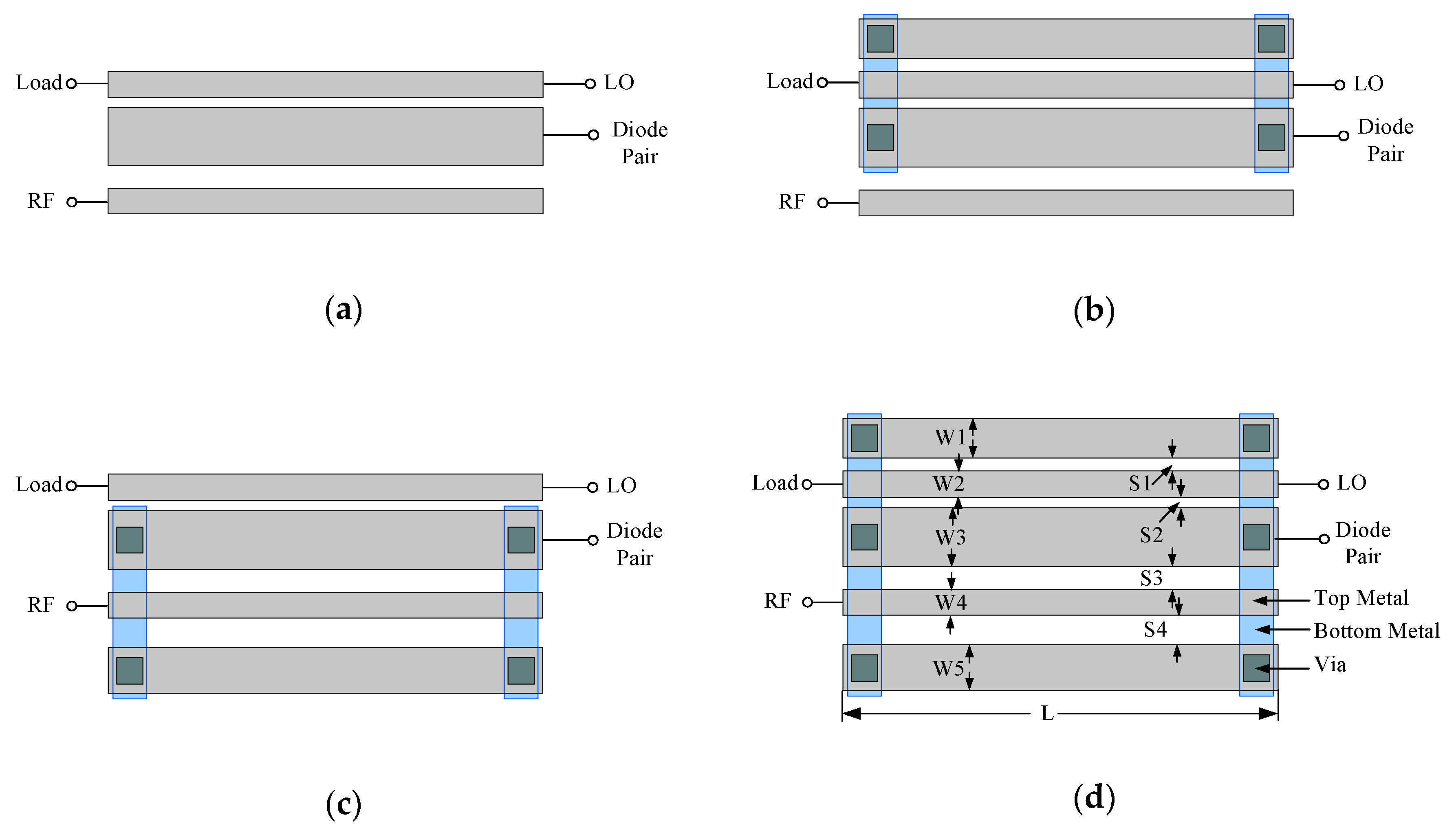
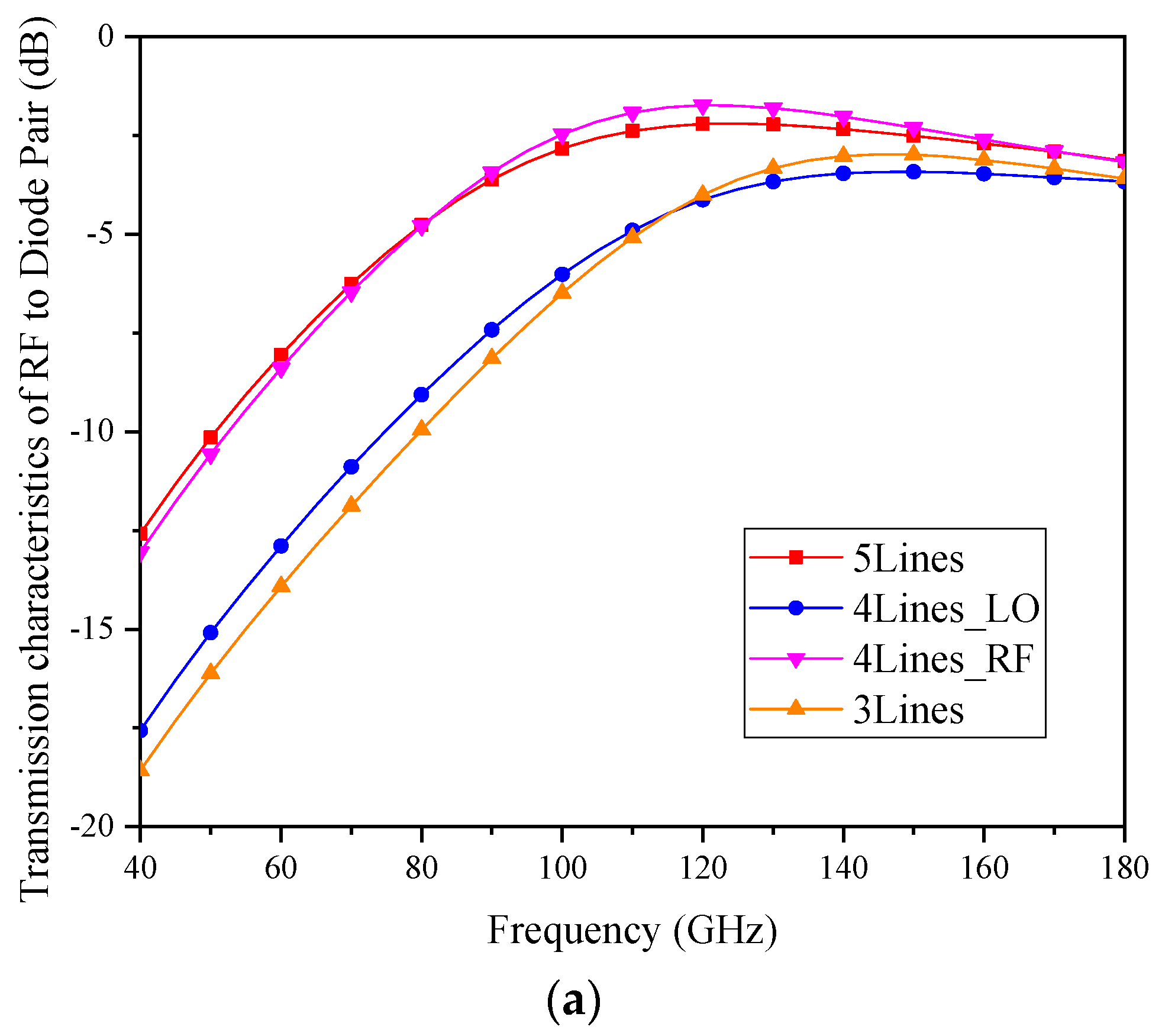


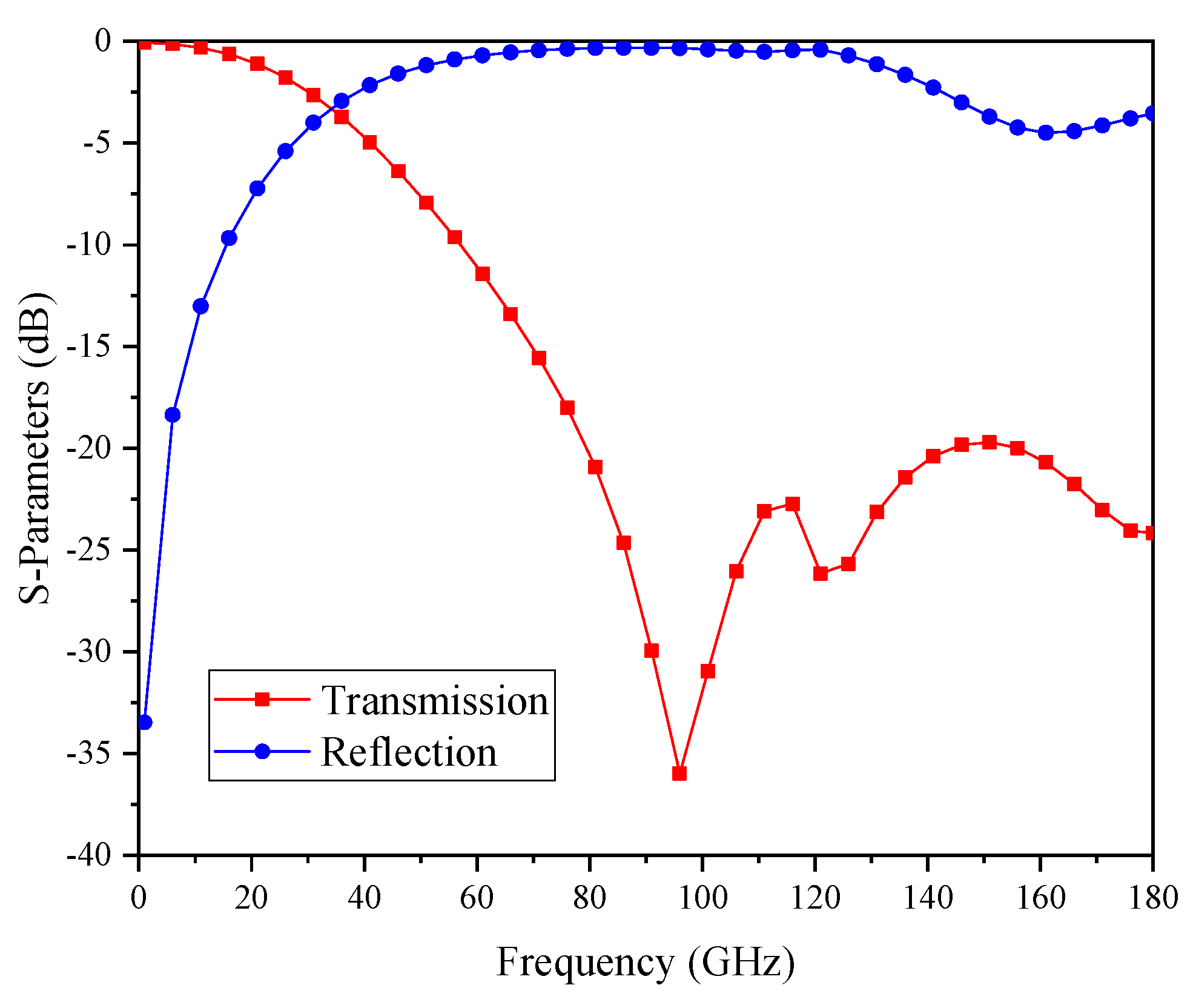


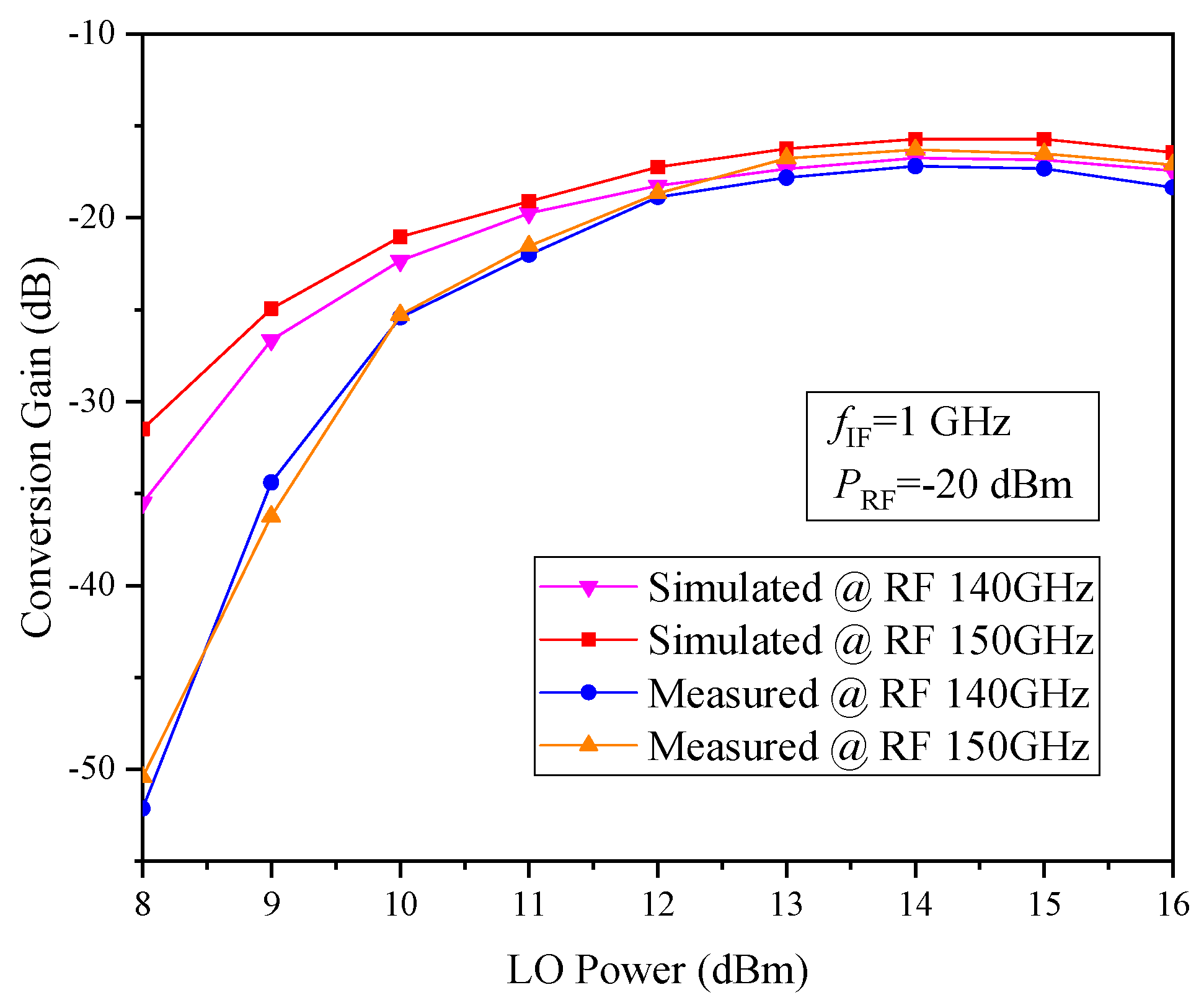
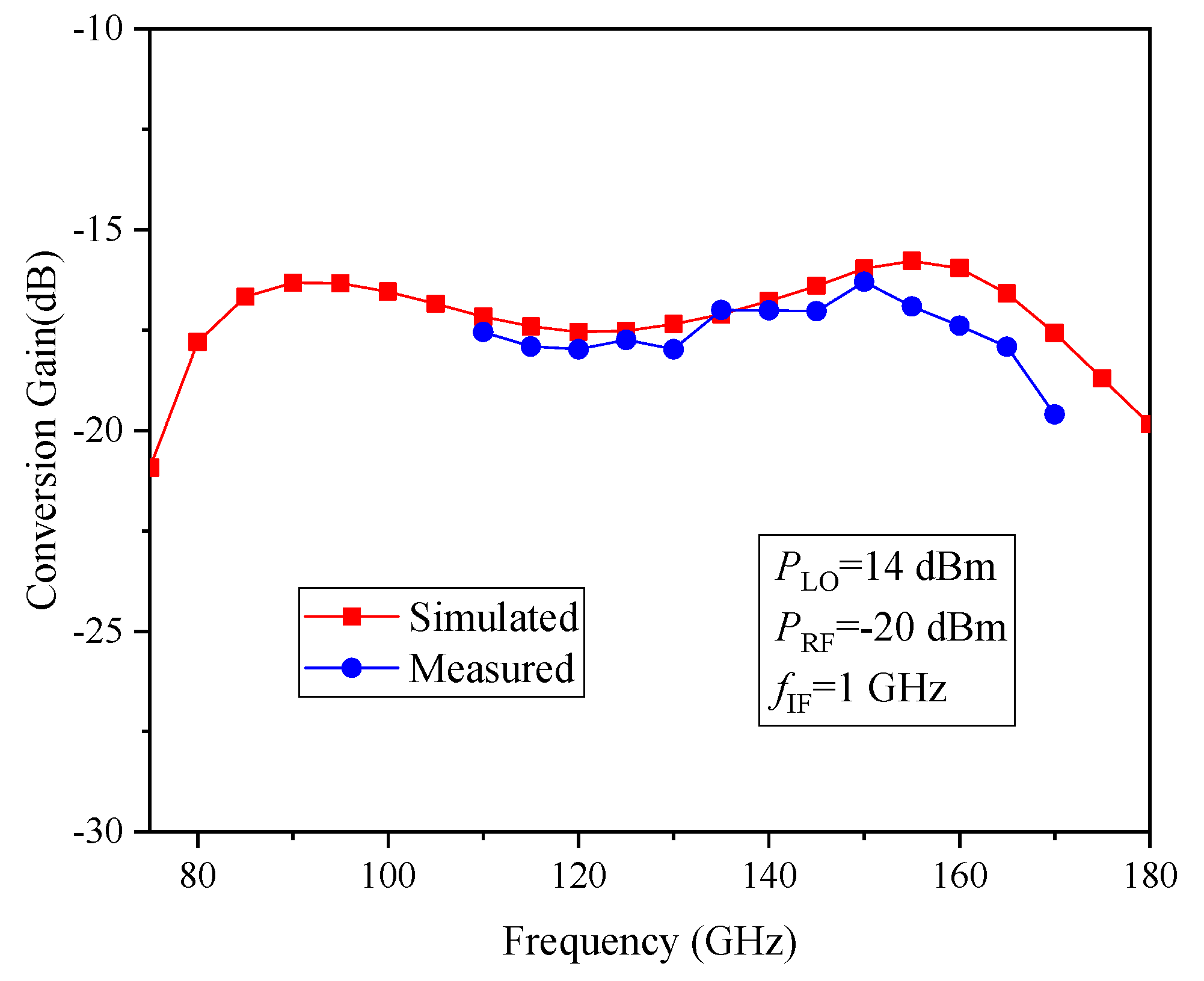
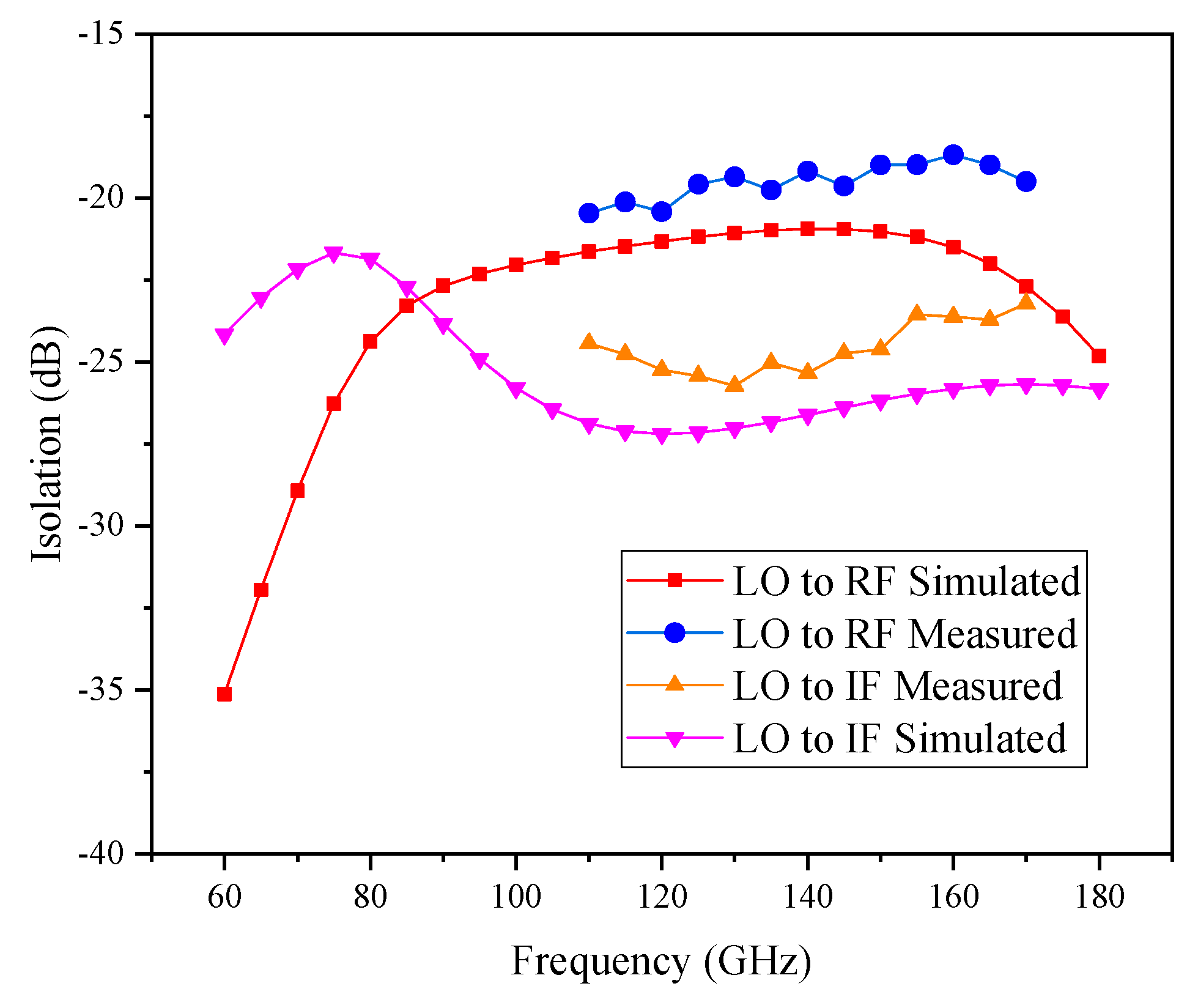
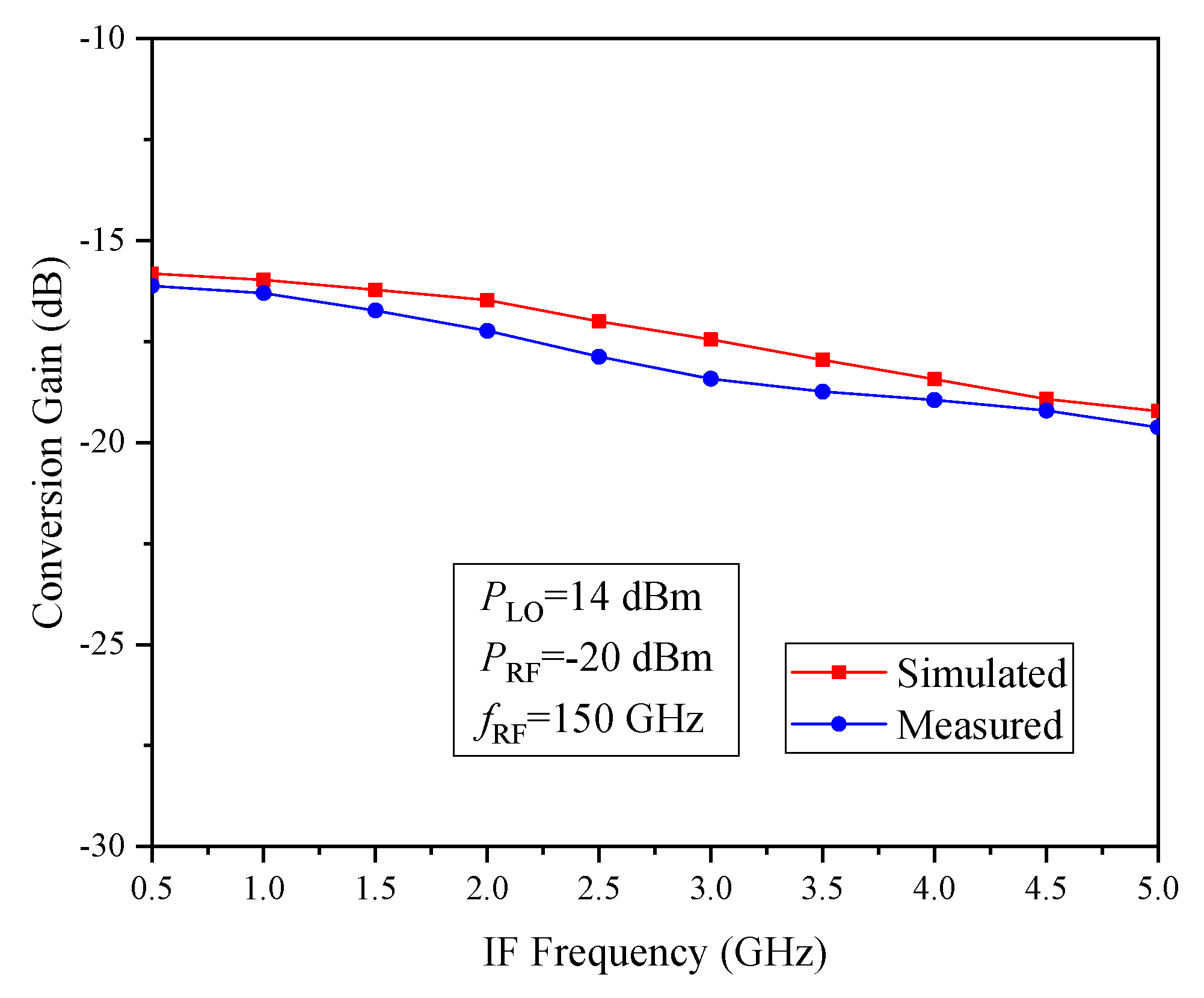
| W1 | W2 | W3 | W4 | W5 |
|---|---|---|---|---|
| 12 μm | 10 μm | 18 μm | 10 μm | 14 μm |
| S1 | S2 | S3 | S4 | L |
| 4 μm | 3 μm | 7 μm | 7 μm | 130 μm |
| Ref. | Topology | Process | Device | Conversion Gain (dB) | RF Frequency (GHz) | LO Power (dBm) | Bandwidth (GHz) | Chip Size (mm2) | FOM1 | FOM2 |
|---|---|---|---|---|---|---|---|---|---|---|
| [8] | 2nd | GaAs | Diode | –12.7 to –16.5 | 200–215 | 8 | 15 | 1.25 × 2.95 | 5.41 | 3.57 |
| [9] | 2nd | 0.15 μm GaAs pHEMT | Diode | –10 to –14 | 78–114 | 10 | 36 | 1.5 × 2.0 | 10.56 | 9.06 |
| [10] | 2nd | 80 nm InP HEMT | Diode | –15 to –30 | 165–187 | 13 | 22 | 1.1 × 1.4 | 5.92 | 5.15 |
| [11] | 4th | 5 μm GaAs Diode | Diode | –20 to –30 | 180–196 | 18.7 | 16 | NA | 2.04 | NA |
| [12] | 2nd | 0.1 μm InP HEMT | Diode | –14.3 to –20 | 110–120 | 8.2 | 10 | 1.7 × 2.0 | 2.85 | 1.15 |
| [13] | 4nd | 0.15 μm GaAs pHEMT | Diode | –25.5 to –30 | 100–120 | 15 | 20 | 1.0 × 1.0 | 0.26 | –0.24 |
| [14] | 2nd | 70 nm GaAs mHEMT | 3μm Diode | –14 to –17 | 110–140 | 9 | 30 | 0.82 × 0.66 | 7.77 | 7.50 |
| [15] | 2nd | 0.13 μm SiGe BiCMOS | Diode | –6 to –7 | 100–120 | 16 | 20 | 0.43 × 0.78 | 10.01 | 9.84 |
| [16] | 2nd | 0.13 μm SiGe BiCMOS | Diode | −8 | 122 | 5 | NA | 0.6 | NA | NA |
| [17] | 2nd | 70 nm GaAs mHEMT | 3μm Diode | –13.9 to –17.5 | 110–145 | 14 | 32 | 0.5 × 0.68 | 8.10 | 7.93 |
| [18] | 4nd (Res.) | 0.15 μm GaAs pHEMT | HEMT | –26 to –30 | 176–186 | 18 | 10 | NA | –3 | NA |
| [19] | 2nd (Res.) | 0.1 μm GaAs mHEMT | HEMT | –14 to –17 | 120–150 | 0 | 30 | 1.0 × 0.9 | 7.77 | 7.32 |
| [20] | 2nd (Res.) | 0.1 μm GaAs mHEMT | HEMT | –12.5 to –16 | 120–150 | 4 | 30 | 1.2 × 1.5 | 8.52 | 7.62 |
| [21] | 2nd (Res.) | 0.1 μm GaAs mHEMT | HEMT | –19 to –28 | 180–220 | 2 | 40 | 1.0 × 2.0 | 6.52 | 5.52 |
| –18.5 to –29 | 200–220 | 2 | 20 | 1.0 × 1.8 | 3.76 | 2.86 | ||||
| [22] | 2nd (Res.) | 50 nm InP HEMT | HEMT | –15.5 to –25 | 180–220 | 3 | 40 | NA | 8.27 | NA |
| HEMT | –16.5 to –22 | 200–220 | 4 | 20 | 4.76 | NA | ||||
| This work | 2nd | 70 nm GaAs mHEMT | 3μm Diode | –16.2 to –19.6 | 110–170 | 14 | 60 | 0.47 × 0.66 | 9.68 | 9.53 |
| –15.8 to –20 * (Simulated) | 80–180 | 100 | 12.10 | 11.94 |
© 2020 by the authors. Licensee MDPI, Basel, Switzerland. This article is an open access article distributed under the terms and conditions of the Creative Commons Attribution (CC BY) license (http://creativecommons.org/licenses/by/4.0/).
Share and Cite
Wen, J.; Zhang, S.; Sun, L. A Compact Broadband Monolithic Sub-Harmonic Mixer Using Multi-Line Coupler. Electronics 2020, 9, 694. https://doi.org/10.3390/electronics9040694
Wen J, Zhang S, Sun L. A Compact Broadband Monolithic Sub-Harmonic Mixer Using Multi-Line Coupler. Electronics. 2020; 9(4):694. https://doi.org/10.3390/electronics9040694
Chicago/Turabian StyleWen, Jincai, Shengzhou Zhang, and Lingling Sun. 2020. "A Compact Broadband Monolithic Sub-Harmonic Mixer Using Multi-Line Coupler" Electronics 9, no. 4: 694. https://doi.org/10.3390/electronics9040694




